Study of the Application Characteristics of Photovoltaic-Thermoelectric Radiant Windows
Abstract
:1. Introduction
2. Mathematical Model
3. Numerical Calculation Process and Experimental Validation
3.1. Numerical Calculation Process
3.2. Experimental Validation
3.3. Experimental Validation and Error Analysis
4. Parameter Optimization of PV-TEC Radiation Window
4.1. Optimization of Thermoelectric Module
4.2. Optimization of Radiation Plate Thickness
4.3. Optimization of Radiation Plate Thickness
5. Conclusions
- (1)
- In the solar thermal radiation window, the ideal spacing of the thermoelectric sheet installed on the thermoelectric radiation plate is 0.28 m. After considering the heat transfer and load-bearing characteristics of the metal radiation plate, 4-mm thick metal aluminum radiation plate is selected as more appropriate.
- (2)
- Comparing the effects of different PV modules on the PV-TEC window, numerical simulations were conducted for non-transparent photovoltaic modules (NTPV) and semi-transparent photovoltaic modules (STPV). The simulation results showed that different PV modules had little effect on the temperature of the components in the thermoelectric window, and the temperature difference was within 0.5 °C. The NTPV with a peak power of 270 W can meet the operating demand of the thermoelectric window, while the STPV with a peak power of 150 W can only meet the power consumption of the thermoelectric window with an operating time of less than 8 h.
Author Contributions
Funding
Institutional Review Board Statement
Informed Consent Statement
Data Availability Statement
Conflicts of Interest
References
- Euntae, Y.; Hend, O.M.; Sung-Gwan, P.; Obaid, M.; Siham, Y.A.-Q.; Pedro, C.; Kangmin, C.; Kyu-Jung, C. A review on self-sustainable microbial electrolysis cells for electro-biohydrogen production via coupling with carbon-neutral renewable energy technologies. Bioresour. Technol. 2021, 320, 124363. [Google Scholar]
- Prieto, A.; Knaack, U.; Klein, T.; Auer, T. 25 Years of cooling research in office buildings: Review for the integration of cooling strategies into the building façade (1990–2014). Renew. Sustain. Energy Rev. 2017, 71, 89–102. [Google Scholar] [CrossRef]
- Wei, H.; Su, Y.; Riffat, S.B.; Hou, J.X.; Jie, J. Parametrical analysis of the design and performance of a solar heat pipe thermoelectric generator unit. Appl. Energy 2011, 88, 5083–5089. [Google Scholar]
- Pei, G.; Fu, H.; Zhang, T.; Jie, J. A numerical and experimental study on a heat pipe pv/t system. Sol. Energy 2011, 85, 911–921. [Google Scholar]
- He, W.; Zhou, J.; Hou, J.; Chen, C.; Ji, J. Theoretical and experimental investigation on a thermoelectric cooling and heating system driven by solar. Appl. Energy 2013, 107, 89–97. [Google Scholar] [CrossRef]
- Shen, L.; Xiao, F.; Chen, H.; Wang, S. Investigation of a novel thermoelectric radiant air-conditioning system. Energy Build. 2013, 59, 123–132. [Google Scholar] [CrossRef]
- Di, L.; Fu-Yun, Z.; Guang-Fa, T. Active low-grade energy recovery potential for building energy conservation. Renew. Sustain. Energy Rev. 2010, 14, 2736–2747. [Google Scholar]
- Liu, Z.; Zhang, L.; Gong, G.; Han, T. Experimental evaluation of an active solar thermoelectric radiant wall system. Energy Convers. Manag. 2015, 94, 253–260. [Google Scholar] [CrossRef]
- Han, T.; Gong, G.; Liu, Z.; Ling, Z. Optimum design and experimental study of a thermoelectric ventilator. Appl. Therm. Eng. 2014, 67, 529–539. [Google Scholar] [CrossRef]
- Liu, Z.B.; Zhang, L.; Gong, G.C. Experimental evaluation of a solar thermoelectric cooled ceiling combined with displacement ventilation system. Energy Convers. Manag. 2014, 87, 559–565. [Google Scholar] [CrossRef]
- Zhang, J.; Zhang, W.; Huang, F.; Zhao, Y.; Zhong, Y. Research on factors and performance of solar thermoelectric radiant window. IOP Conf. Ser. Earth Environ. Sci. 2021, 675, 012083. [Google Scholar] [CrossRef]
- Xu, S.; Liao, W.; Huang, J.; Kang, J. Optimal PV cell coverage ratio for semi-transparent photovoltaics fades in central China on office building fac. Energy Build. 2014, 77, 130–138. [Google Scholar] [CrossRef]
- Shen, L.; Tu, Z.; Hu, Q.; Tao, C.; Chen, H. The optimization design and parametric study of thermoelectric radiant cooling and heating panel. Appl. Therm. Eng. 2017, 112, 688–697. [Google Scholar] [CrossRef]
- Liao, W. Comprehensive Energy Consumption Study of Translucent Monocrystalline Photovoltaic Glass in Building Applications; Huazhong University of Science and Technology: Wuhan, China, 2015. [Google Scholar]
- Daghigh, R.; Khaledian, Y. Effective design, theoretical and experimental assessment of a solar thermoelectric cooling-heating system. Sol. Energy 2018, 162, 561–572. [Google Scholar] [CrossRef]
- The American Society of Heating, Refrigeration and Air Conditioning Engineers (ASHRAE). Radiant Heating and Cooling. In ASHRAE Handbook: HVAC Systems and Equipment; ASHRAE: Peachtree Corners, GA, USA, 2016. [Google Scholar]
- Ministry of Housing and Urban-Rural Development. Design Code for Heating Ventilation and Air Conditioning in Civil Buildings; China Construction Industry Press: Beijing, China, 2012. [Google Scholar]
- Ministry of Housing and Urban-Rural Development. Technical Specification for Radiant Heating and Cooling; China Construction Industry Press: Beijing, China, 2012. [Google Scholar]
- Lim, H.; Jeong, J.W. Energy saving potential of thermoelectric modules integrated into liquid desiccant system for solution heating and cooling. Appl. Therm. Eng. 2018, 136, 49–62. [Google Scholar] [CrossRef]
- Han, L.; Kang, Y.K.; Jae-Weon, J. Thermoelectric radiant cooling panel design: Numerical simulation and experimental validation. Appl. Therm. Eng. 2018, 144, 248–261. [Google Scholar]
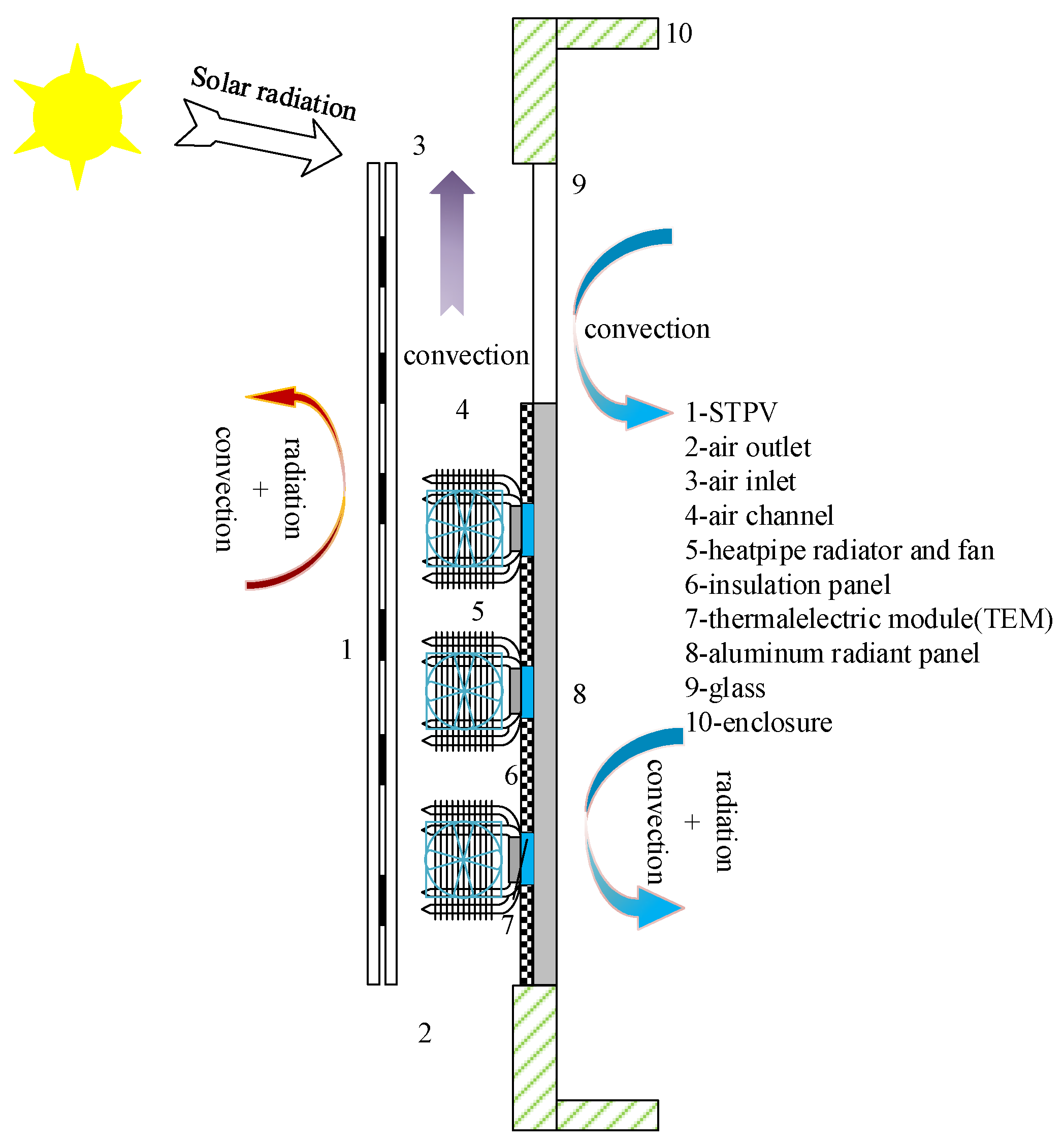
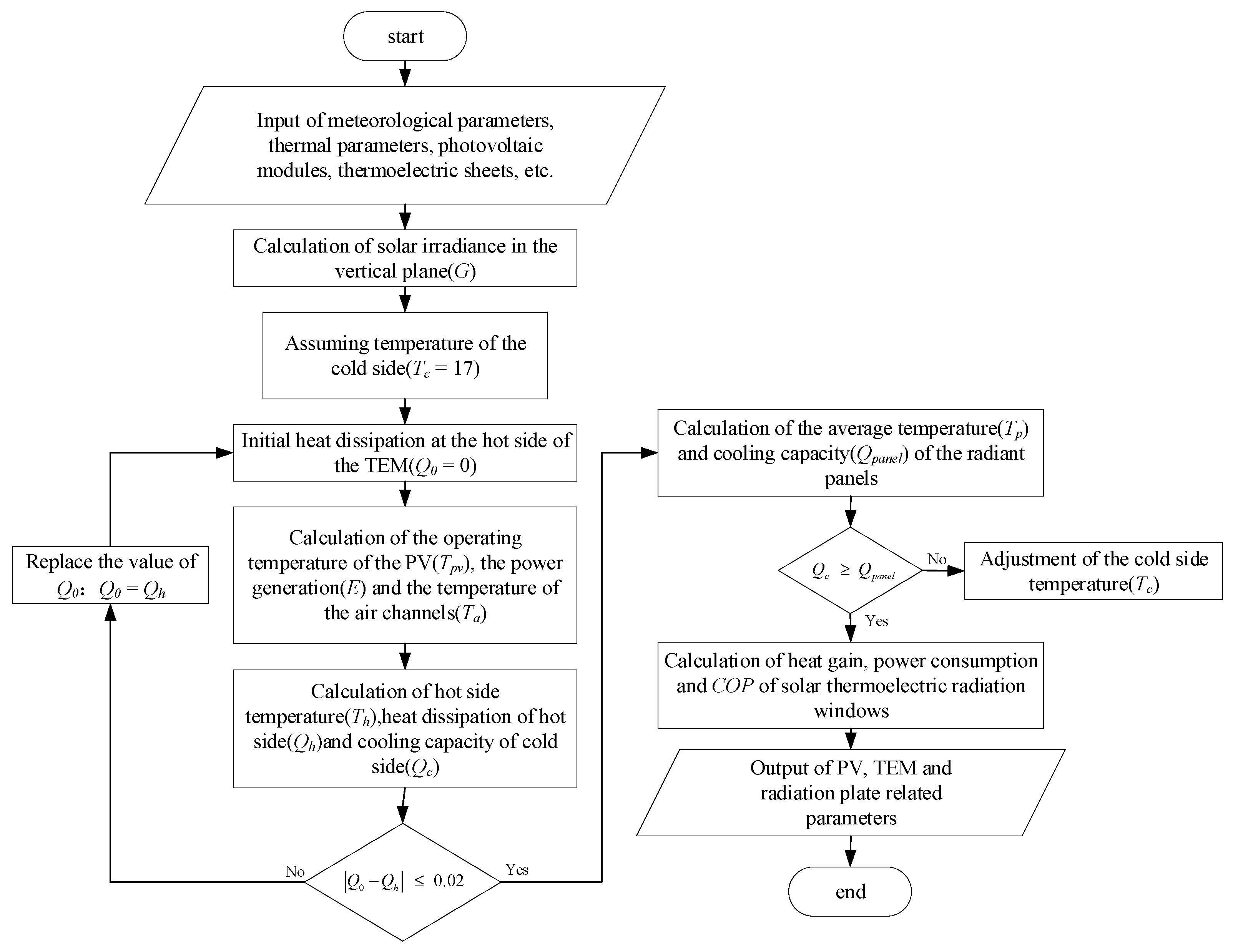
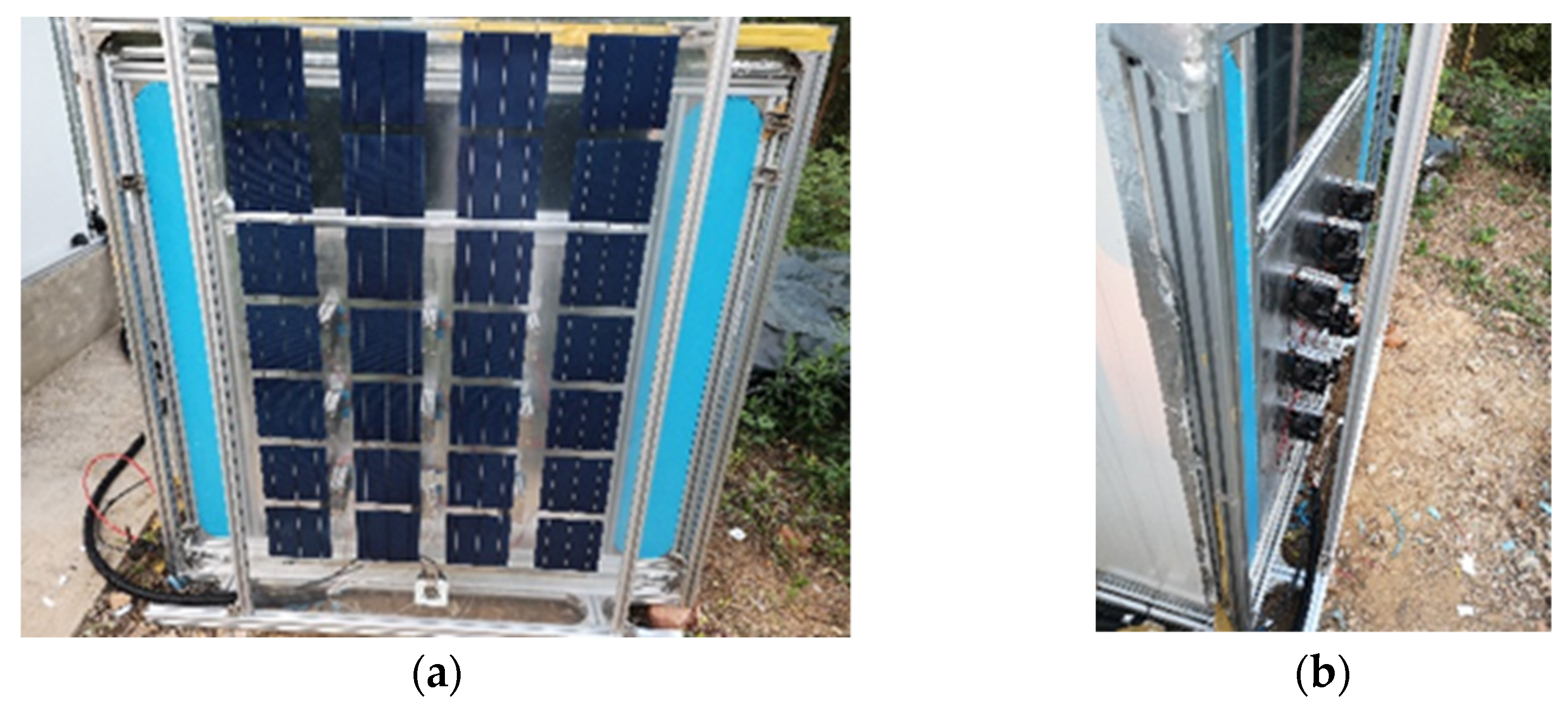
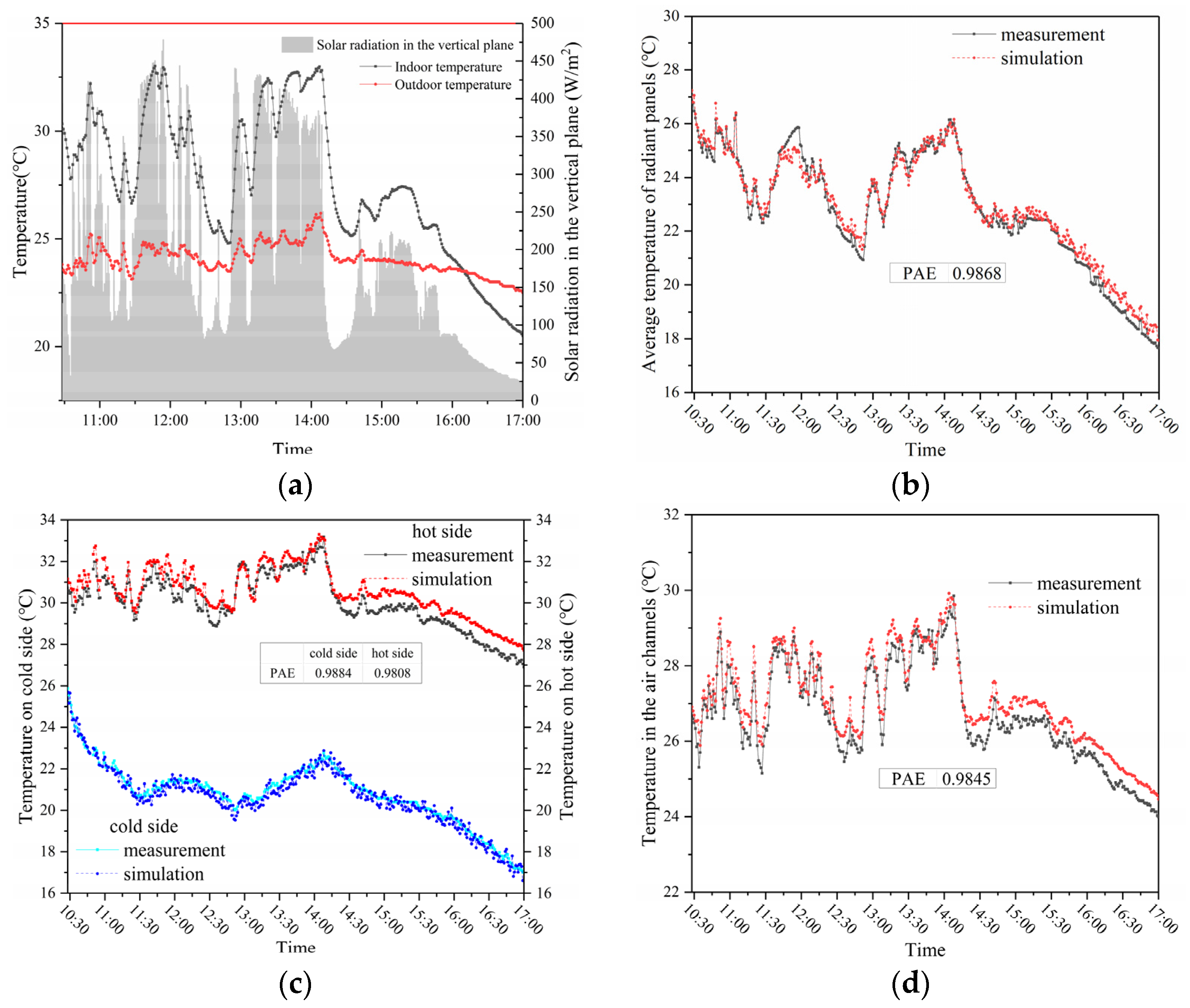


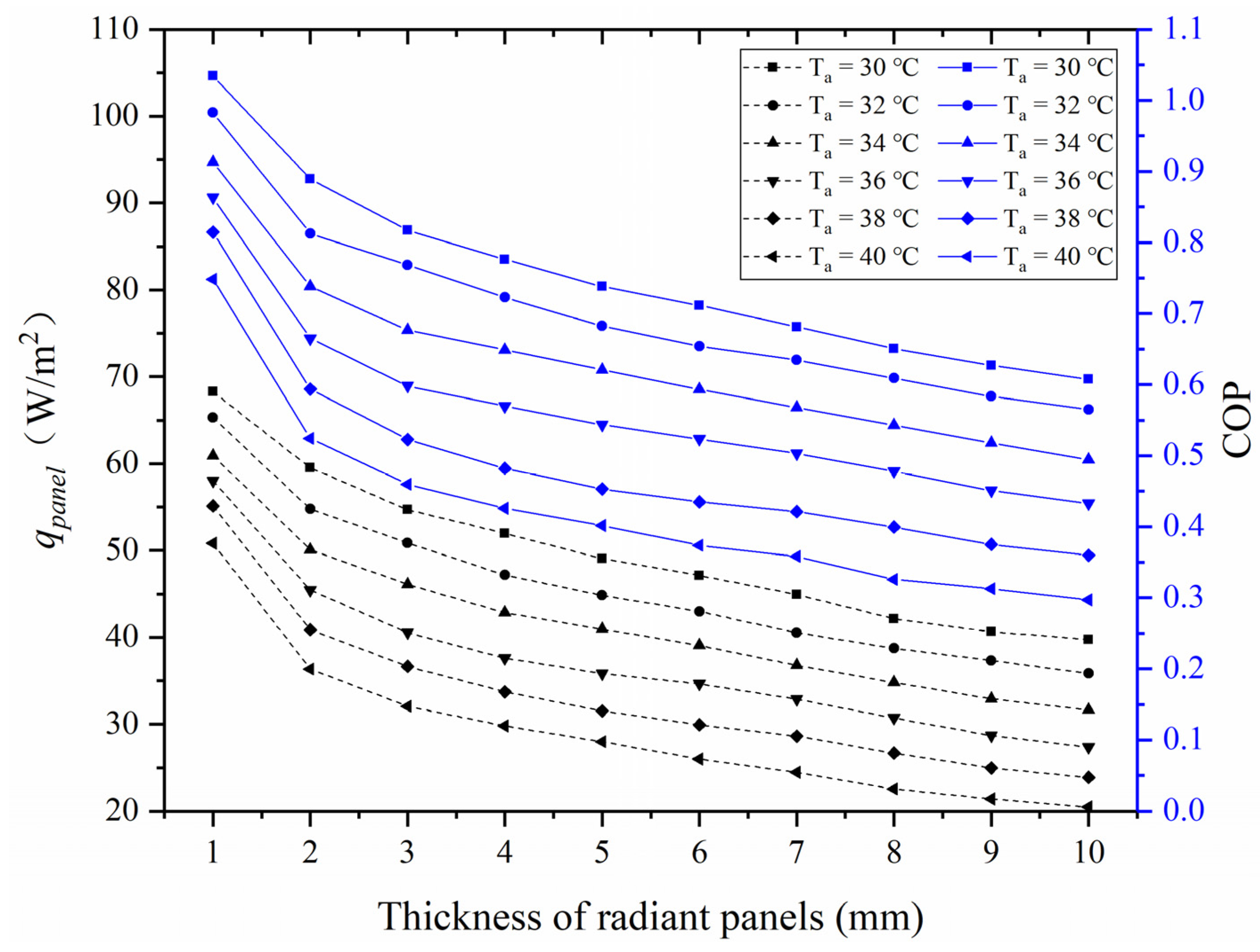
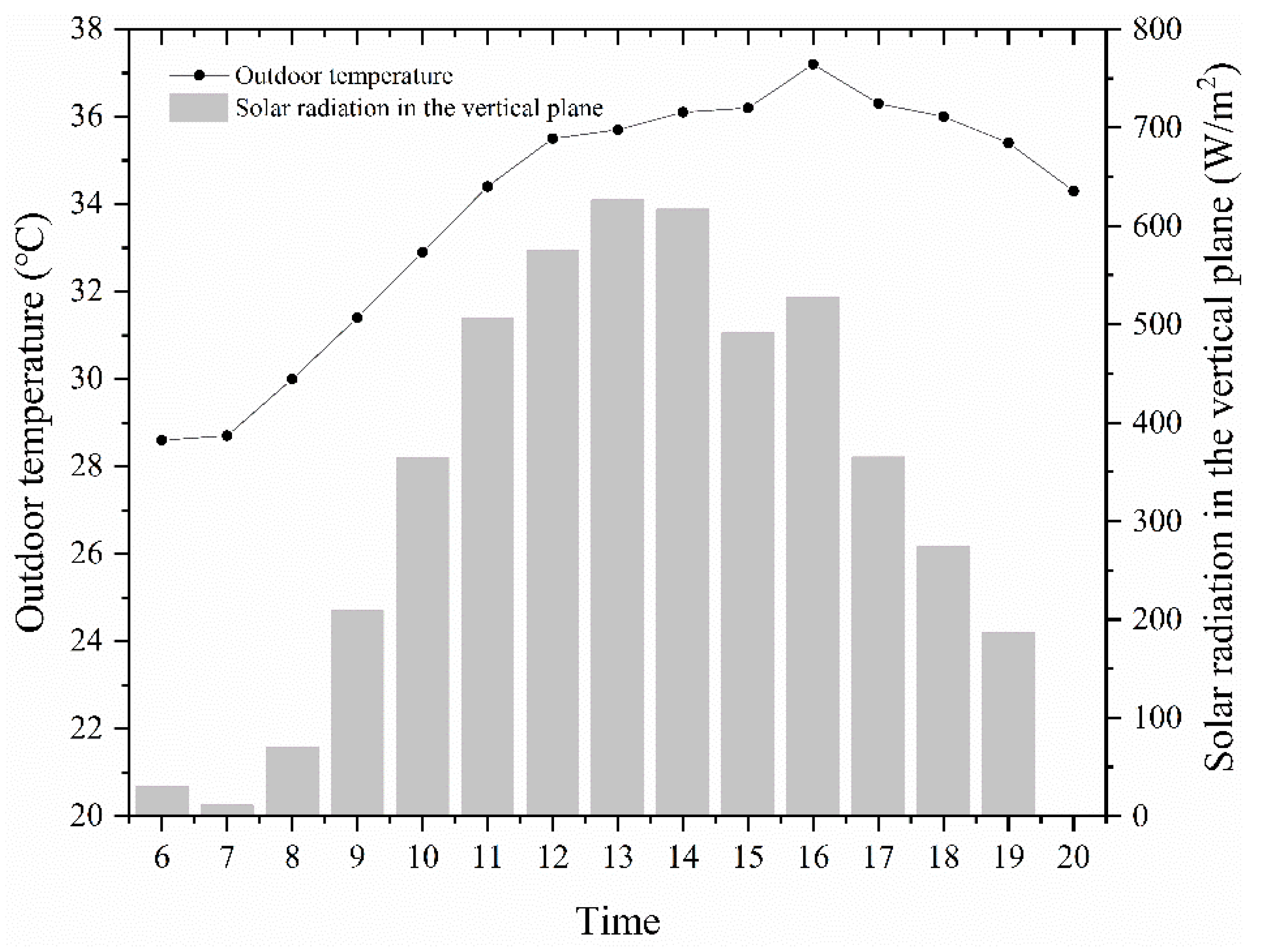
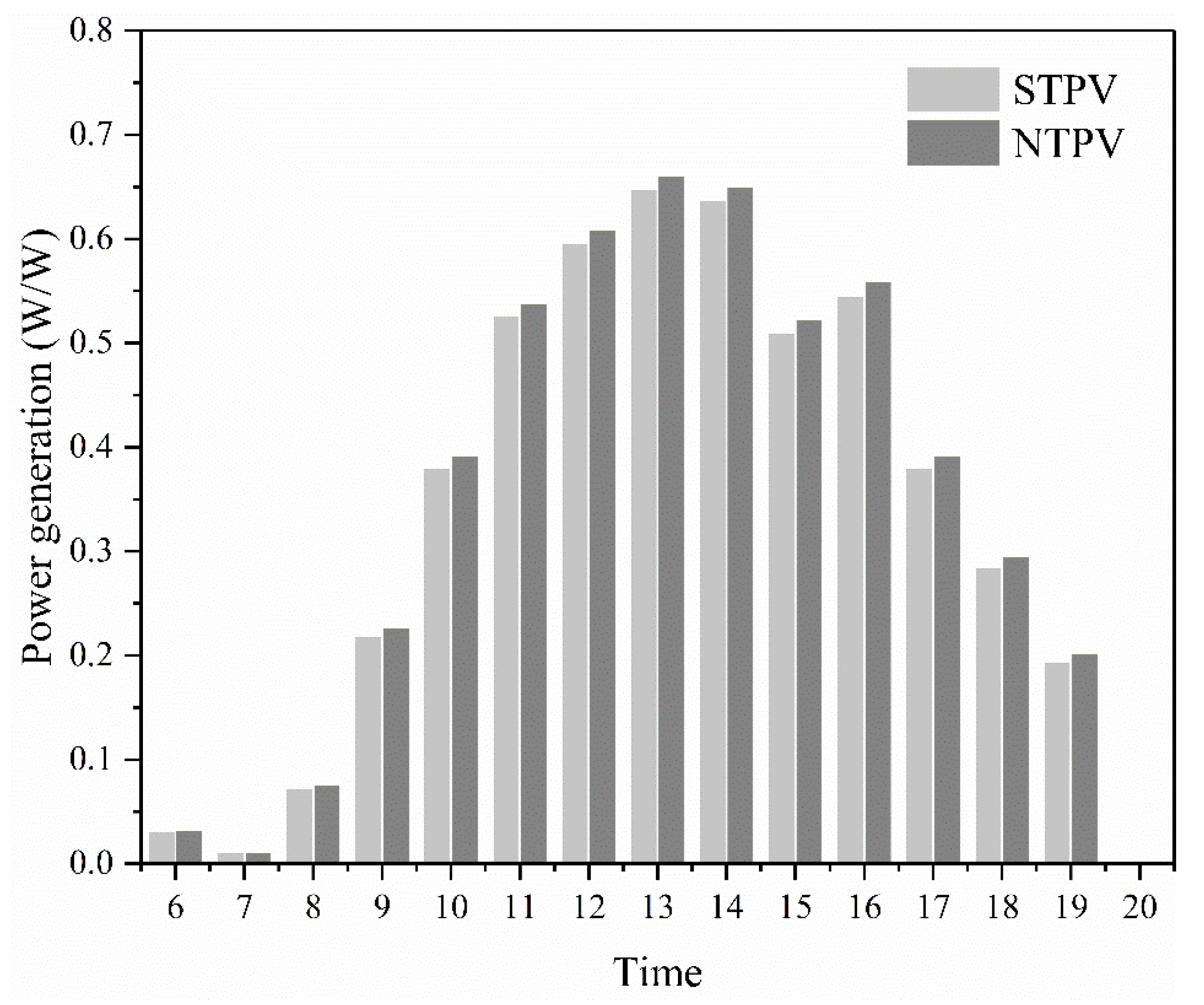
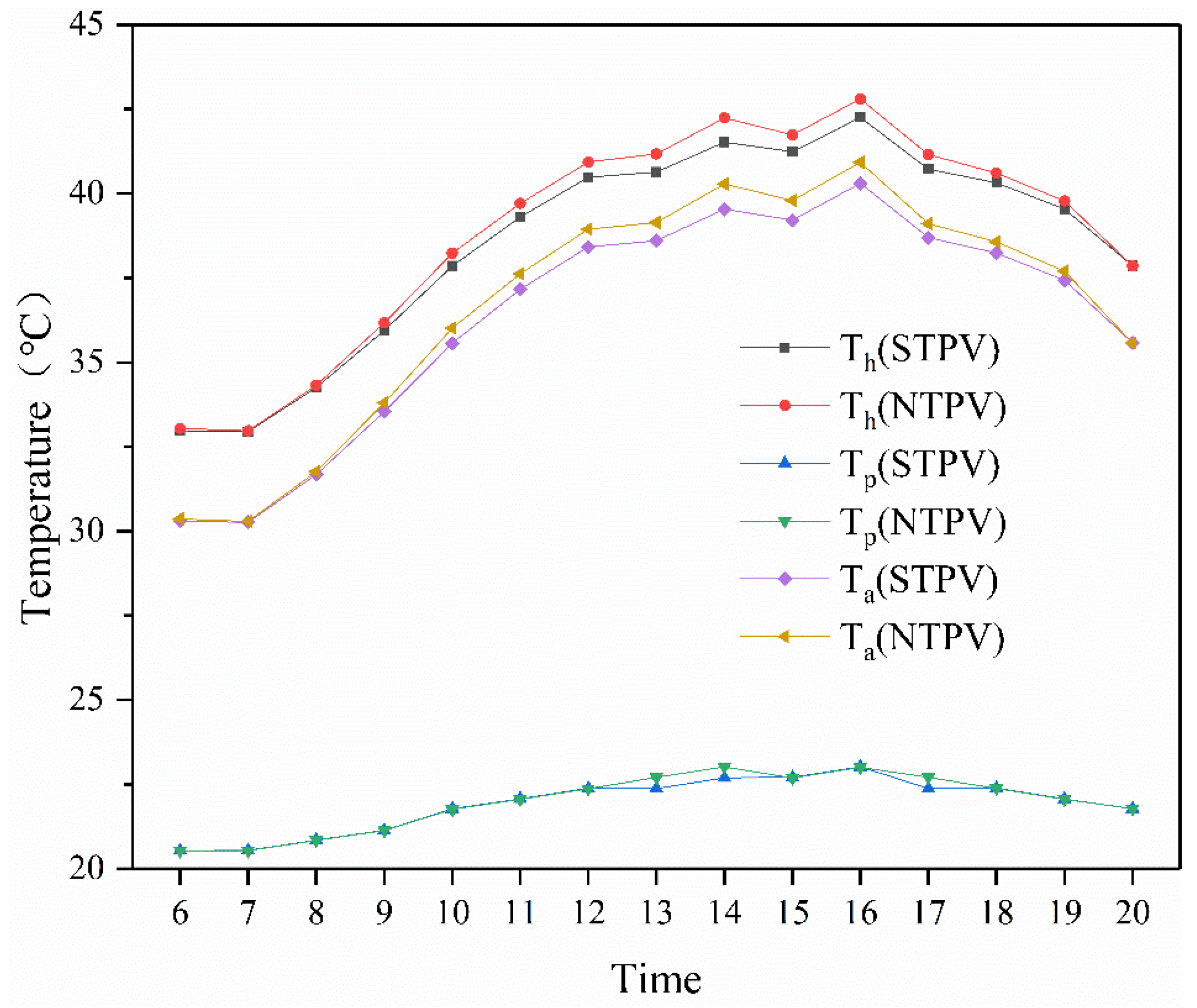

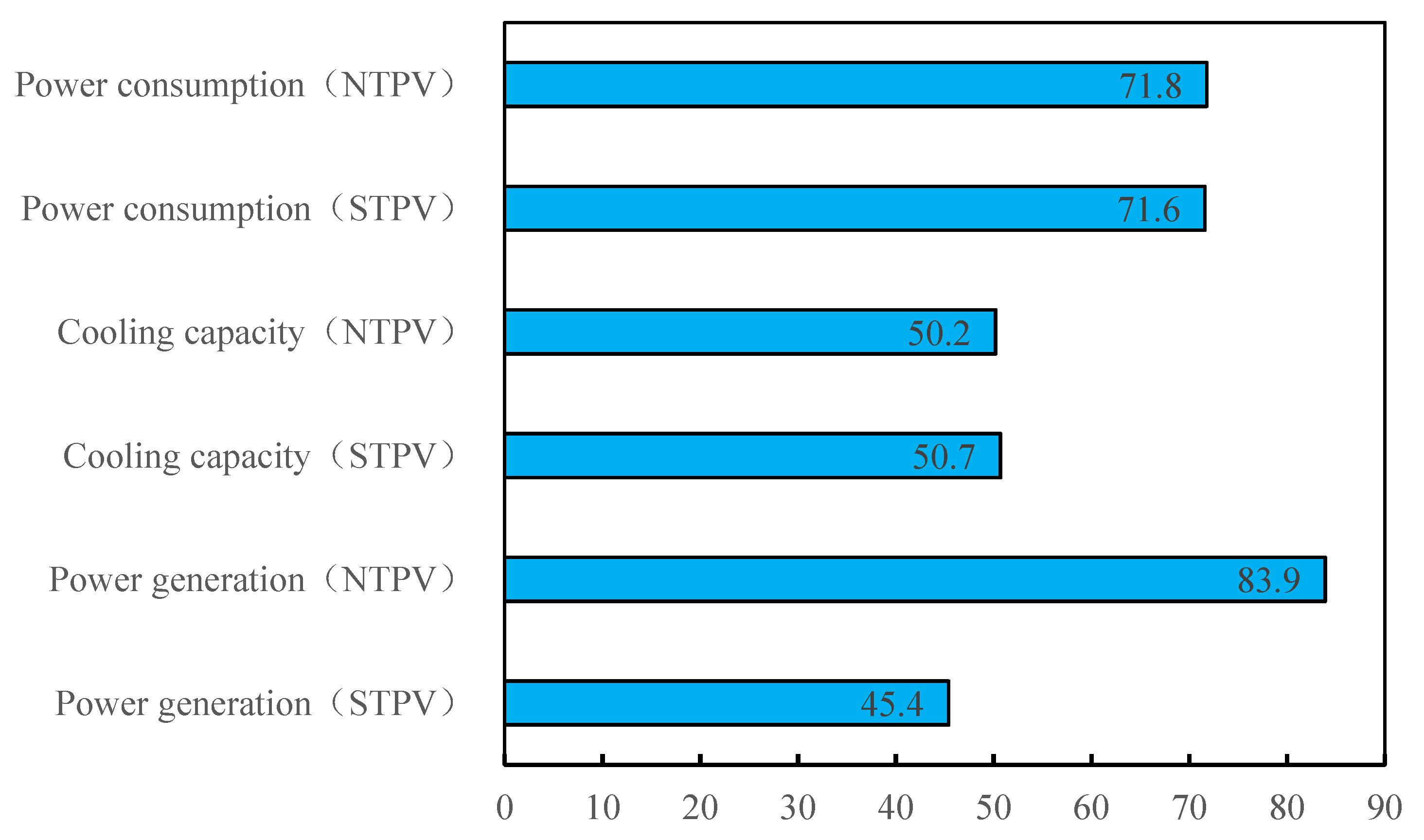
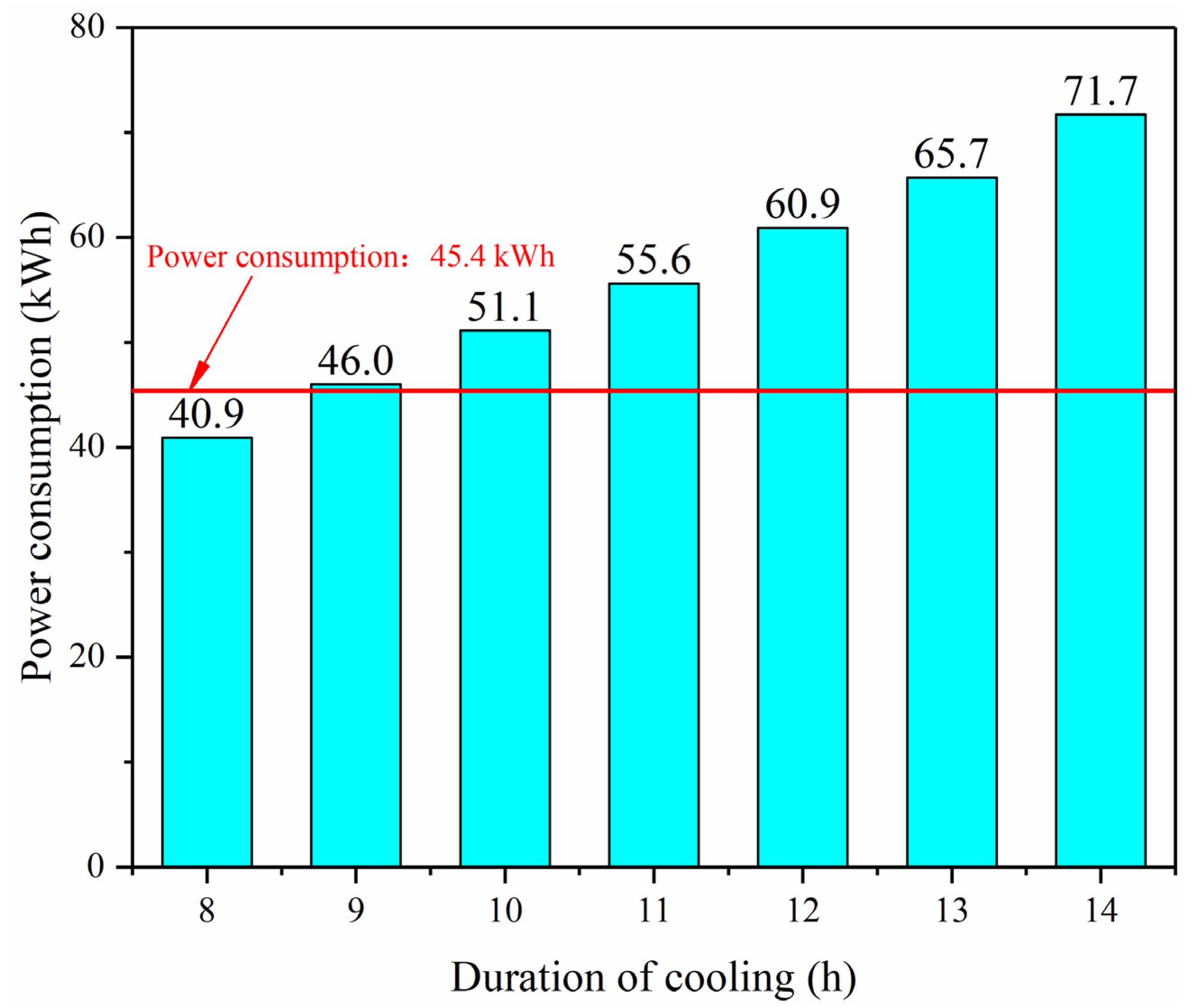
| Parameter Name (Unit) | Numerical Value |
|---|---|
| Thermal conductivity of metallic radiation panels (W/(m·K)) | 273 |
| Specific heat capacity of metal radiation plate (J/(kg·K)) | 880 |
| Density of metal radiation plate (kg/m3) | 2730 |
| Thickness of metal radiation plate (m) | 0.004 |
| Integrated heat transfer coefficient of insulation material (W/(m2·K)) | 0.109 |
| Parameter Name (Unit) | NTPV | STPV |
|---|---|---|
| Short-circuit current(A) | 9.22 | 8.88 |
| Open-circuit voltage(V) | 37.9 | 21.3 |
| Max. power point current(A) | 8.73 | 8.38 |
| Max. power point voltage(V) | 30.9 | 17.9 |
| Current temperature coefficient | −0.06% | −0.06% |
| Peak power(W) | 270 | 150 |
| Area of solar cells(m2) | 1.46 | 0.69 |
Publisher’s Note: MDPI stays neutral with regard to jurisdictional claims in published maps and institutional affiliations. |
© 2021 by the authors. Licensee MDPI, Basel, Switzerland. This article is an open access article distributed under the terms and conditions of the Creative Commons Attribution (CC BY) license (https://creativecommons.org/licenses/by/4.0/).
Share and Cite
Zhang, W.; Zhang, J.; Huang, F.; Zhao, Y.; Zhong, Y. Study of the Application Characteristics of Photovoltaic-Thermoelectric Radiant Windows. Energies 2021, 14, 6645. https://doi.org/10.3390/en14206645
Zhang W, Zhang J, Huang F, Zhao Y, Zhong Y. Study of the Application Characteristics of Photovoltaic-Thermoelectric Radiant Windows. Energies. 2021; 14(20):6645. https://doi.org/10.3390/en14206645
Chicago/Turabian StyleZhang, Wenjie, Jiajun Zhang, Fengcheng Huang, Yuqiang Zhao, and Yongheng Zhong. 2021. "Study of the Application Characteristics of Photovoltaic-Thermoelectric Radiant Windows" Energies 14, no. 20: 6645. https://doi.org/10.3390/en14206645
APA StyleZhang, W., Zhang, J., Huang, F., Zhao, Y., & Zhong, Y. (2021). Study of the Application Characteristics of Photovoltaic-Thermoelectric Radiant Windows. Energies, 14(20), 6645. https://doi.org/10.3390/en14206645






